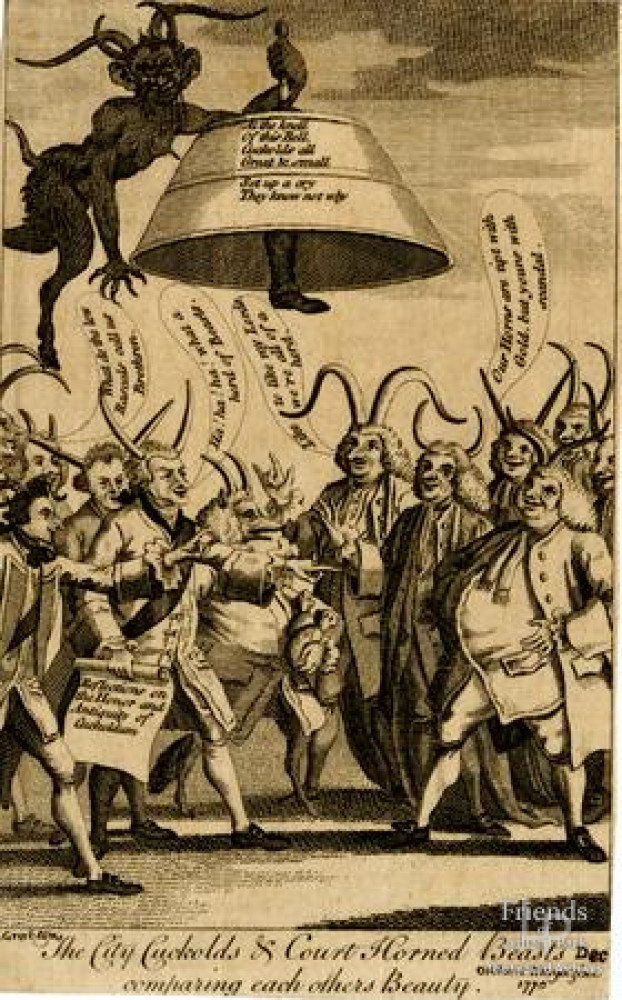Satire and the St.John Family
The Lydiard Archives contain a number of satirical cartoons referring to members of the St John family. Satire uses humour, irony, exaggeration or ridicule to expose and criticize people’s vices, particularly in a political or topical context.
The earliest cartoon in the archive is from about 1621 and the original is in the British Museum. It is called “The Description of Giles Mompesson late Knight censured by Parliament the 17th of March, Anno 1620.”
Sir Giles Mompesson was married to Katherine St.John, sister to Sir John St.John 1st Bt (d1648) of Lydiard Park. He was deeply unpopular in the country, and considered a notorious criminal on account of his being awarded lucrative monopolies by King James I, who created numerous monopolies as a way of raising money. Sir Giles benefited from regulating inns & alehouses as well as the gold thread industry. His name came to be regarded as a synonym for official corruption and this type of cronyism and patronage was a contributory factor leading to the British Civil War. Mompesson’s name was invoked as a symbol of all that was wrong with the aristocracy and Sir Giles Overreach, the anti-hero of Philip Massinger’s 1625 play A New Way to Pay Old Debts is based on him.
In 1621 Giles Mompesson was not only “degraded” from his knighthood by Parliament but was also banished abroad. His wife Katherine St.John petitioned relentlessly for his return. She joined him in France in June 1622 and he returned to England the following year, only to be ordered abroad again. In 1628 he returned again and subsequently managed a coalmining venture in the Forest of Dean for his sister-in-law Barbara Villiers. He was a royalist during the English Civil War and died in 1651, still bemoaning his disgrace. His will referred to “that small estate which it hath pleased God of His infinite goodness and mercy to afford me after so many and grievous crosses, afflictions and calamities.’
The British Museum online collection catalogue describes the engraving:
The three scenes in this print show Giles Mompesson insulting the landlady of the Bell Inn, who defends herself with a spit; fleeing from a gaoler; and as a lame and penniless exile in France, limping on crutches, ruing his folly in taking on a monopoly; he is followed, in the background, by Sir Richard Empson and Edmund Dudley, the hated extortionate ministers of Henry VII; below the moral is pointed in four verses.
The British Museum engraving, dating from 17 March 1621, is the earliest known British satirical print concerned with a parliamentary political issue.
A different sort of satire is represented in another, later, cartoon in the Lydiard Archives. This cartoon features Frederick 2nd Viscount Bolingbroke, and is called “The City Cuckolds and Court Horned Beasts comparing each other’s beauty.” It appeared in the Oxford Magazine in 1770.
This is a satire on the friction between the government supporters and the City of London who are both representing each other as horned cuckolds. The group on the left includes the Duke of Grafton, Viscount Bolingbroke and Henry Fox. One of the men on the right, wearing lawyer’s robes, may be intended for James Eyres, Recorder of the City of London. Behind him a man grins and says: “Our Horns are tipt with Gold, but yours with scandal”. Above them the devil holds a large bell made up of a petticoat and boot, alluding to the relationship of Princess Augusta and Lord Bute.
Augusta was the widow of Frederick, Prince of Wales and Lord Bute was the Prime Minister who had been appointed with her support in 1762. However, his appointment gave rise to such immense public hostility that he was forced to resign only a year later. Amongst the scandals spread against him and Augusta was that they were involved in an affair. This was entirely scurrilous and invented. In contrast, the private life of the Duke of Grafton and his wife were colourful and immoral; they were both unfaithful and he was granted a divorce in 1769. Similarly, Frederick 2nd Viscount Bolingbroke was unfaithful to his wife Lady Diana Spencer and she to him. He divorced her in 1768. By linking the case of Princess Augusta and Lord Bute to that of two accepted adulterers and cuckolds, the satirist sought to tar them with the same brush and damage them politically.



